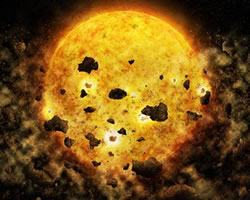Brandon Specktor* says recent observations of a space drama 45 light years from Earth provide evidence of the eventual fate of our solar system.
 In a violent preview of how our solar system could die seven billion years from now, astronomers have seen the remnants of a dead planet as it tumbled onto the surface of a dead star.
In a violent preview of how our solar system could die seven billion years from now, astronomers have seen the remnants of a dead planet as it tumbled onto the surface of a dead star.
In doing so it confirmed decades of speculation about what happens to solar systems that reach the end of their lives.
These explosive observations — which were taken with NASA’s Chandra X-ray Observatory — provide a preview of the violent future that may await Earth and its sun billions of years from now, the authors wrote in a study published in the journal, Nature.
Lead study author, Tim Cunningham said the detection provided the first direct evidence that white dwarfs were currently accreting the remnants of old planetary systems.
Dr Cunningham, a postdoctoral fellow at the University of Warwick in the United Kingdom, said probing accretion in this way offered a glimpse into the likely fate of the thousands of known exoplanetary systems, including our own solar system.
About 97 per cent of all stars in the Milky Way will end their lives as white dwarfs — shrivelled, crystalline star cores that pack about a sun’s-worth of mass into an orb no larger than Earth.
The transition from a bright, burning star to a dense, white corpse is anything but peaceful.
After an old star burns through the last of its fuel, it balloons into a red giant, smashing through any inner solar system planets unlucky enough to be nearby.
Soon after, the star sheds its outer layers in an enormous eruption of hot gas that sweeps across its solar system.
At the centre of this chaos, a white dwarf is born.
Scientists suspect that planets, or whatever’s left of them, can continue to orbit around a white dwarf in a dusty boneyard called a debris disk.
Sometimes, those planetary remnants can even spiral into the dead star’s surface and become part of the dwarf.
Prior studies looking at the elemental composition of nearby white dwarfs have found traces of heavy metals like iron and magnesium mixed into the dead stars’ atmospheres, suggesting the presence of gobbled-up rocky planet chunks.
Those studies relied on a technique called spectroscopy, essentially a way of studying the wavelengths of light emitted by an object to figure out what that object is made of.
As such, any evidence of dead stars gobbling up dead planets has been indirect, until now.
Using the Chandra’s x-ray telescope, the authors of the new study focused on a nearby white dwarf called G29–38, located about 45 light-years away in the Pisces constellation and known to have an atmosphere polluted with metals.
With Chandra, the researchers isolated G29–38 in their field of vision and watched for signs of high-energy explosions coming from the dwarf’s surface, suggesting that some sort of impact had occurred.
Sure enough, the team successfully detected x-ray emissions coming from the white dwarf. From the brightness of the blasts, the team measured the heat of the explosions.
They found that the plasma on the star’s surface had heated to more than one million degrees Celsius, which aligns perfectly with models of planetary bodies smashing into white dwarves, the researchers said.
According to the authors, these observations offer the first direct evidence that white dwarves suck in and gobble up the rocky remains of the planets that once orbited them.
The x-ray flashes occurred billions of years after the formation of G29–38’s planetary system, suggesting that a similar fate could await Earth when our sun begins its inevitable final act several billion years from now.
*Brandon Specktor is a senior writer for Live Science. He enjoys writing about space, geoscience and the mysteries of the Universe.
This article originally appeared on the Live Science website.



